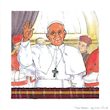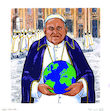Biography of Pope Saint John Paul II
About this article
A brief biography of the life of Pope Saint John Paul II.
Saint John Paul II was born Karol Josef Wojtyla (Voy-tee-wah) on May 18, 1920, in Wadowice (Vah-do-vee-juh), Poland, a small city just outside Krakow. He was the third and youngest child of Karol Wojtyla Sr., a lieutenant in Poland's army, and Emilia Kaczorowska (Kash-or-uv-ska), the daughter of a Krakow upholsterer. His older brother, Edmund, was born in 1906, and his sister, Olga, who died in infancy, was born about 1914. Tragically, Karol would lose the rest of his family by the time he was twenty. His mother died in 1929 when Karol was eight, and his brother died of scarlet fever just three years later at the age of 31, cutting short a promising career as a doctor. His father passed away in 1941, when Karol was just twenty years old.
Despite the early losses of his mother and his siblings, Karol had a typical childhood. He and his father were close, sharing midday meals when Karol returned from school and walking together every evening after supper. Like other young people, Karol enjoyed playing sports like soccer, skiing in the mountains, skating on the Skawa River in the winter, and swimming there in the summer. During his high school years, Karol met Mieczyslaw Kotlarcyzk, who encouraged his budding acting abilities in a form of theater that celebrated Polish culture.
After finishing high school in 1938, Karol and his father moved to Krakow, where Karol enrolled in Jagiellonian University. He was forced to leave his studies when the Nazis invaded Poland and closed the school. During the Nazi occupation, Karol worked in a stone quarry and in a chemical factory. Had Karol not had these vital jobs, the Nazis likely would have deported him to Germany or sent him to the concentration camps. In an act of resistance to the Nazi occupation, Karol continued to perform in the Rhapsodic Theater, an underground theater that preserved the Polish language and culture in a time when one could be shot for merely speaking Polish. In 1942, after more than two years of discernment, Karol entered the underground seminary of Krakow, run by Cardinal Adam Stefan Sapieha, the archbishop of Krakow. Karol was ordained in the fall of 1946 and immediately went to Rome where he finished his doctorate in theology at the Angelicum University.
Father Wojtyla returned to Krakow in 1948 and served as a chaplain at Jagiellonian University while continuing his studies. He completed a second doctorate in 1953, at Lublin Catholic University, and taught at the major seminary in Krakow and at Lublin. In 1958, after being appointed by Pope Pius XII, he was consecrated auxiliary bishop of Krakow by Archbishop Baziak. Bishop Wojtyla traveled to Rome again, this time to participate in the historic Vatican II Council. He was nominated archbishop of Krakow in 1964 by Pope Paul VI, who made him a cardinal in 1967.
Archbishop Wojtyla was elected pope on October 16, 1978, after the death of Pope John Paul I. Wojtyla refused the usual coronation ceremony and was instead installed as pope in a Mass in Saint Peter's Square in Rome. The first non-Italian pope since the sixteenth century, John Paul II quickly became one of the most recognizable figures in the world. In January 1978, just three months into his papacy, he made his first pastoral trip to the Dominican Republic, Mexico, and the Bahamas--the first of many trips outside Rome. Pope John Paul II was the most traveled, and arguably the most visible, pope in history, making pastoral visits to more than one hundred countries during his papacy, including six trips to the United States.
Ironically, it was at home in Vatican City that Pope John Paul II almost lost his life to an assassin's bullet. On May 13, 1981, while riding through Saint Peter's Square and greeting pilgrims who had traveled to see him, the pope was shot. As he lay wounded, he recalled that May 13 was the same day the Virgin Mary had appeared to three children at Fatima. To this day, he credits Our Lady of Fatima with saving his life. He later visited his would-be assassin, Mehmet Ali Agca, and forgave him.
Forgiveness, in fact, was a theme throughout his papacy, but especially so in later years. In preparation for the great Jubilee Year 2000, Pope John Paul II not only exhorted individuals to greater self-reflection and forgiveness of others, but he also modeled the same for the entire Church, asking for the forgiveness of other faiths, particularly the Jewish faith, for wrongs the Church had committed against them in the past.
In his tenure as pope, John Paul II made over 200 pastoral visits; wrote numerous encyclicals, letters, constitutions, and exhortations; published three books; presided at the canonization of more than 450 saints; instituted the annual World Youth Day celebrations for young people; and presided at each Synod of Bishops held since he assumed the papacy. He was canonized by Pope Francis on April 27th, 2014.
Clearly, by his actions, presence, and great love of the Church's people and its Tradition, this remarkable man has made the Church stronger, richer, and better able to be the presence of Christ in the world in the new millennium. We will miss him and the spirit he brought to both the Church and the world.
Acknowledgments
(Copyright © 2003 by Saint Mary's Press. Permission is granted for the free use of this article for classroom or campus ministry purposes; however, it may not be republished in any form without the written permission of Saint Mary's Press. For more resources to support your ministry, call 800-533-8095, or visit our Web site at www.smp.org.)
Published






